List of 15 Notorious Roman Emperors and Empresses
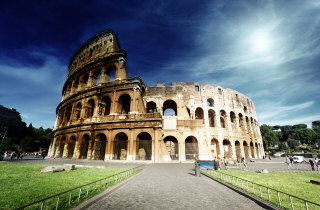 Rome is one of the most important
statements of democratic ideals and social development in the history of
civilization. That today all great civilizations use Ancient Rome for
benchmarking their own success as a nation. Its immense scientific, cultural, and political legacy
stems from over two millennia of existence. At its peak, the Roman empire
controlled lands from Egypt in Africa to the British Isles. However, as it is
with most things in life, nothing is perfect. Although Rome has seen excellent
leaders and rulers that brought about its greatest achievements, it also had
plenty of second class Emperors that destroyed the hard work of their
predecessors, for various reasons—most of which were petty. Here's a list of the
15 infamous Roman emperors and empresses that appeared in its long, history, in
the order of their reign. Rome is one of the most important
statements of democratic ideals and social development in the history of
civilization. That today all great civilizations use Ancient Rome for
benchmarking their own success as a nation. Its immense scientific, cultural, and political legacy
stems from over two millennia of existence. At its peak, the Roman empire
controlled lands from Egypt in Africa to the British Isles. However, as it is
with most things in life, nothing is perfect. Although Rome has seen excellent
leaders and rulers that brought about its greatest achievements, it also had
plenty of second class Emperors that destroyed the hard work of their
predecessors, for various reasons—most of which were petty. Here's a list of the
15 infamous Roman emperors and empresses that appeared in its long, history, in
the order of their reign.
15) Caligula
(A.D. 37 – 41)
Actually named Gaius Julius Caesar Augustus Germanicus, the emperor earned
the nickname Caligula from the caligae, military boots worn by legionaries. As a
child, he accompanied his father, Germanicus, on a military campaign in northern
Germania, where he was issued a miniature legionary uniform, which included
little soldier boots. The nickname was formulated by legionaries who were amused
by the child, much to the future emperor's chagrin. When Emperor Tiberius died
in A.D. 37, Caligula became heir to the office along with Tiberius's grandson.
He overturned the old emperor's will and made himself the sole heir.
Although Caligula was initially a wise emperor focusing on the long term and
implementing many popular changes, everything soon took a turn for the worse.
When Caligula fell ill seven months into his reign, the downwards slope began.
He executed Tiberius' grandson to secure his position. When the treasury began
to run dry due to extensive bribing, Caligula began falsely accusing,
imprisoning, and executing the wealthy of Rome just to seize their assets.
Eventually, he started to consider himself a living god and expected citizens to
worship him. Contemporary historians described him as increasingly insane,
wasting money, and committing increasingly erratic acts, such as appointing his
horse as a priest. After a four year reign, Caligula was finally assassinated on
22nd January 41, along with nearly his entire family, save for Caligula's uncle,
Claudius, who was proclaimed Emperor by the Praetorian Guard.
14) Agrippina
the Younger (A.D. 49 – 54)
Wife to Emperor Claudius, Agrippina was a beautiful Roman noblewoman who
possessed high intelligence and was enormously cunning. Once exiled by Emperor
Caligula based on an alleged plot against his life, Agrippina was returned to
Rome with her family restored to their proper standing by Emperor Claudius, her
uncle. As political marriage was one of the tools through which Emperors and
leaders of Rome affirmed their position, Agrippina became a natural choice after
Claudius executed his wife for treason. The union was seen as a chance to
reconcile the bitter feud between the Julian and Claudian branches of the same
house.
Agrippina the Younger
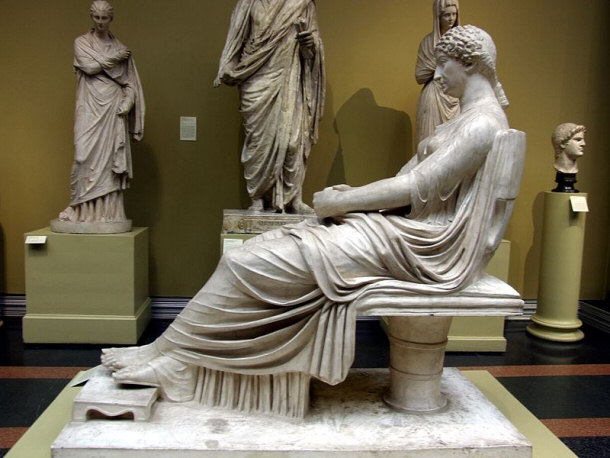
By shakko (Own work) [GFDL or CC-BY-3.0],
via Wikimedia Commons
Agrippina proved to be a masterful schemer. Her machinations and sheer skill
ended up with her being granted the title of Augusta (never before bestowed upon
a woman) and maneuvering her husband into naming Agrippina's son, Nero, as
Claudius' successor. The Emperor eventually marked himself for death, as
disillusioned with Agrippina he began to favor his son, Brittanicus, as heir to
the Imperial throne. Agrippina certainly earned her infamy when, as is generally
accepted, she had the Emperor assassinated during a feast with poisoned
mushrooms.
13) Nero (A.D. 54 – 68)
Agrippina's son is certainly one of the most well known emperors of Rome.
Nero, as the new ruler of Rome, quickly consolidated his power, eliminating his
mother's allies throughout the court and finally banishing her from the palace.
The campaign to consolidate power culminated with Agrippina's execution in A.D.
59. Nero was a popular ruler among the common folk, in no small part due to his
actions during the Great Fire of Rome in A.D. 64. Although he is often stated to
be singing and playing while the city burned, contemporary accounts state the
opposite: Nero organized a relief effort in the city and later opened his palace
to shelter the homeless in the wake of the fires.
Roman Emperor Nero

What truly made him infamous were his actions after the fire. The urban
redevelopment plan implemented by Nero focused on the construction of Domus
Aurea: a massive palace complex spread in the heart of the city, covering an
estimate 100 to 300 acres. The palace had many wasteful features that drained
the treasury and caused the emperor to lose popularity. The 30 foot tall
Colossus of Nero may have been a bit much, as were the tributes imposed on the
rest of the Empire to cover the costs of building the entire complex.
Ultimately, after losing to the rebellion of Galba (who really didn't like
Nero's tax policy), the Emperor would commit suicide in A.D. 68.
12) Domitian (A.D. 81 – 96)
Depending on who you ask, Domitian was either a very good emperor or the
incarnate of evil. Spending his youth in the shadow of his brother, Titus,
Domitian only ascended to the throne in A.D. 81, after his brother died after a
period of illness. The emperor's policies were very progressive, aiming to
expand the defenses on the borders of the Empire as well as strengthening the Roman
currency and economy. It will also aid with rebuilding the city of Rome, and restoring it to
splendor after the Great Fire that destroyed it over a decade earlier. His
approach to ruling made him very popular among the common folk, but not the
Senate.
Roman Emperor Domitian
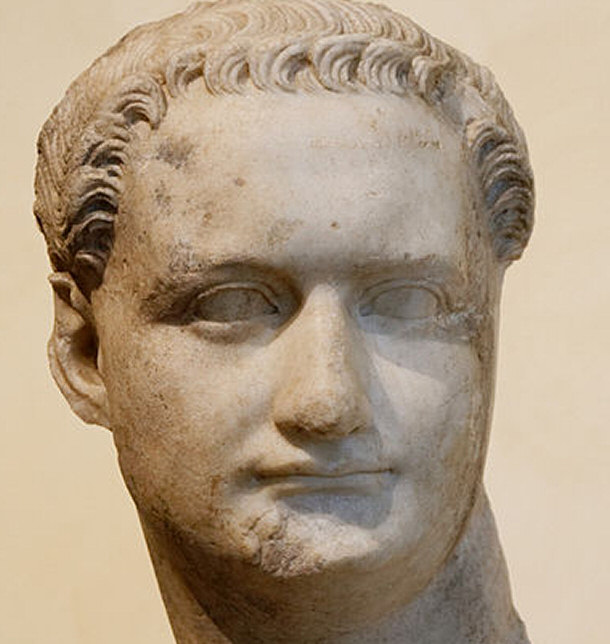
The reason for this was simple. Domitian implemented numerous laws and
practices that can be only described as totalitarian. Styling himself an
enlightened despot after Octavian Augustus, Domitian established a cult of
personality focused on himself, aided by propaganda in all aspects of life. He
also nominated himself perpetual censor, in an attempt to control morality in
Rome. All of these actions antagonized the Senate, which saw him as a dangerous
despot. Domitian was murdered in a palace conspiracy in A.D. 96. The conspiracy
was welcomed by the Senate, which sentenced the late Emperor to oblivion: all
references to him were to be struck from record, effectively erasing him from
history. Obviously, these efforts did not succeed.
11) Commodus (A.D. 180 – 192)
Well known to moviegoers as the antagonist of Ridley Scott's blockbuster, the
Gladiator, Commodus is one of the most notorious Roman Emperor. He appeased the
Roman people with lavish displays of power and grand festivals, leading to his
great popularity with the common folk and, as usual, very low with the Senate.
As a powerfully built man, he even partook in gladiatorial combat directly. To
fund his initiatives, he taxed the members of the Senate, all the while he
consolidated his power through intrigue and subterfuge. He reached the apex of
his power circa 185-190, becoming increasingly corrupt.
Roman Emperor Commodus
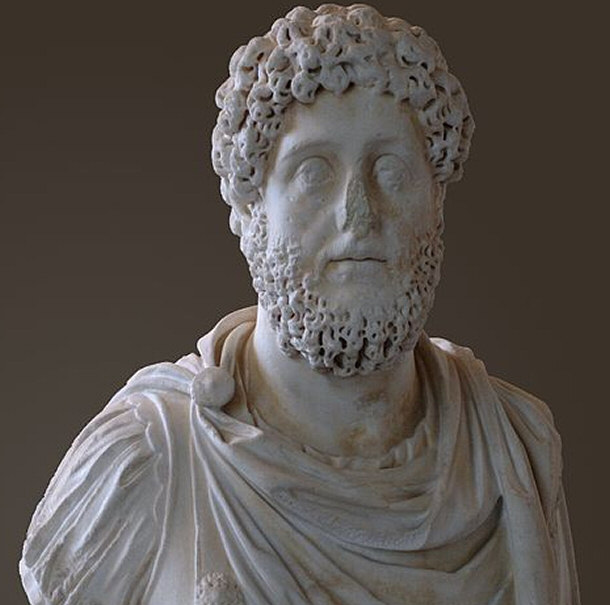
One of the features of this period was Commodus selling the highest offices
in the empire to the highest bidder, starting with Senate positions, through
governorships of provinces, up to consulships. His erratic policies and
decisions led to increasing unrest among the empire, to which he responded with
brutal force. Commodus is perhaps most notorious for the last three years of his
rule, when he proclaimed himself a living god and had numerous statues erected
in his honor throughout the Empire. The situation peaked in 192, when he dubbed
himself the new Romulus and ritually re-founded Rome, renaming it, the Senate,
all citizens of Rome, the legions, and even shipments of grain to Rome after
himself. In December 192, after he was poisoned during a feast, Commodus was
strangled by his own wrestling partner in bed. The Senate promptly declared the
deceased a public enemy and reversed his earlier decisions, including restoring
the city's rightful name.
10) Caracalla (A.D. 198-217)
Quite possibly one of the worst emperors in the history of Rome, Caracalla
initially ruled together with his father, Severus, until his death in 211.
Caracalla showed his true face in 211 when he murdered Geta, his co-ruler and
brother. He murdered his brother in order to secure the office of Emperor exclusively for himself. Of
course, what followed were summary executions of Geta's supporters, including
his family. His rule was increasingly brutal and erratic. For instance, to keep
the Senate and wealthy families of Rome in check, he forced them to construct
palaces and places of entertainment in peripheral territories of the Empire at
their own cost. Heavy taxation was also imposed on most of the population, much
of which was granted Roman citizenship just to increase tax revenue.
Roman Emperor Caracalla
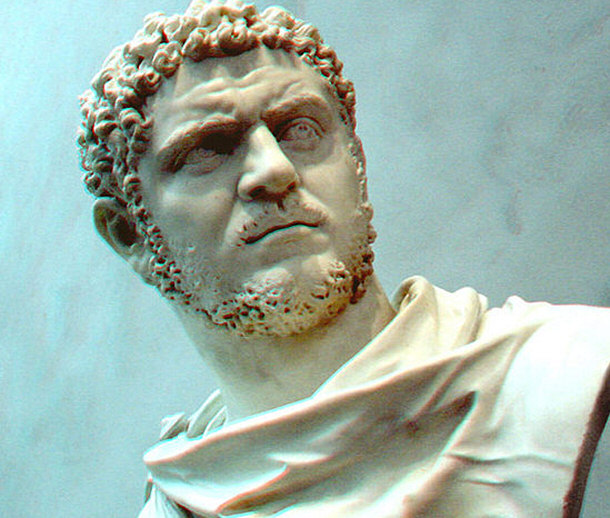
Perhaps the worst of Caracalla's actions was his savagery. When Alexandria's
inhabitants mocked the emperor's claims that he killed his brother in self
defense, Caracalla responded by slaughtering the city's delegation that came to
greet his arrival in Alexandria and then had his troops sack the city, killing
thousands and bringing it to ruin. Unpopular with the common folk and the elite
both, Caracalla held to his power thanks to his legions. Ironically, it's the
military that was his undoing, as the Emperor was murdered while urinating at
the side of a road by one of his own Praetorians in 217.
9) Elagabalus (A.D. 218 – 222)
Quite possibly the weirdest of Roman Emperors, Elagabalus was not responsible
for large scale massacres like Caracalla or attempts to dominate public life
like Domitian. Scarcely 14 years old when he ascended to the throne, Elagabalus
gained infamy for his irreverence for religious traditions and sexual standards
of Rome. Elagabalus was brought to power after Emperor Macrinus, the former head
of the Praetorian Guard of the assassinated Caracalla, was deposed by the
legions and the Senate established Elagabalus as their reigning ruler. The decision quickly
backfired on all of the involved, as the new Emperor wasn't too keen on adhering
to tradition or conventional morality.
Elagabalus Pictured on Ancient Roman Coin
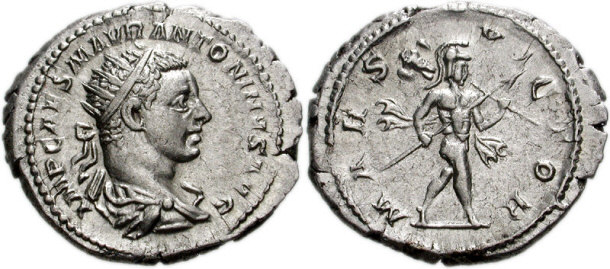
Classical Numismatic Group, Inc. //www.cngcoins.com [GFDL or CC-BY-SA-2.5],
via Wikimedia Commons
His reign started off with the installation of Elagabal, the deity he served
as a boy, as the supreme deity of the pantheon, above Jupiter. As if to
underscore his disregard for standards, the Emperor also married a Vestal
Virgin, ostensibly to produce godlike children. But Elagabalus did not stop
there. He used the imperial palace for orgies and debauchery, only to continue
to prostituting himself in taverns, brothels, and even the palace itself.
Reportedly, his most stable relationship was with his slave chariot driver,
Hierocles, whom the Emperor repeatedly called his husband. Allegedly, Elagabalus
even sought surgeons that would be able to give him female genitalia. His
eccentricities alienated everyone and Elagabalus was finally assassinated along
with his mother in 222, and dumped in the Tiber river.
8) Maximinus Thrax (A.D. 235-238)
Described as a giant of a man, Maximinus was the first emperor never to set
foot in Rome, instead living out of army barracks with his legions. His origins are
those of obscurity. Maximinus Thrax was born in Thrace, to parents of low
standing. He was socially elevated by his military service, achieving one of the highest
offices under the reign of emperor Alexander Severus. Maximinus' popularity
eventually led to him being nominated as Emperor, just as the young Alexander
was assassinated by his own legion. The choice was grudgingly accepted by the
Senate, which had misgivings about the son of a peasant assuming the office of
the Emperor.
Roman Emperor Maximinus Thrax
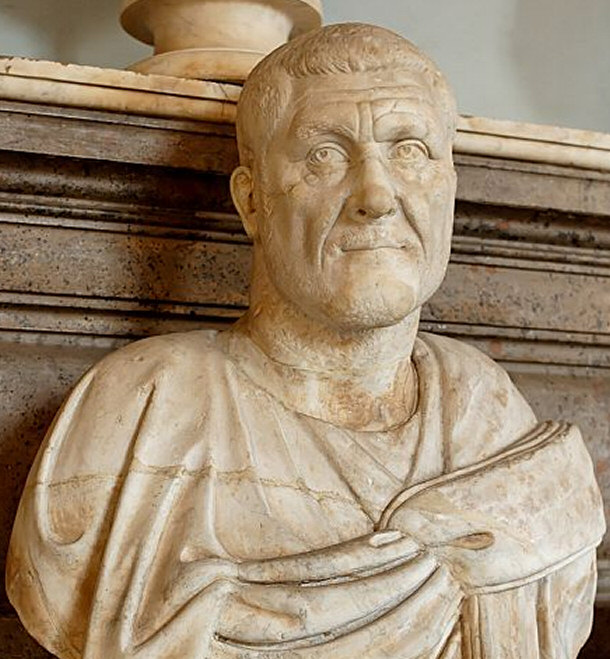
Maximinus was characterized by extreme pettiness. His recollection of the
scorn he faced while down on his luck, led to retaliation once he became
Emperor. His origins became a curse to him, one which caused him to attack both
those that scorned him and those that protected him during his times of trouble.
Executions were widespread and focused on those that were aware of the Emperor's
origins in the common folk. His short reign was beset by rebellions, culminating
in the siege of Rome in 238. Forced to lay siege to the city, the legions,
already disillusioned with Maximinus, murdered him, his cabinet, and his son.
Their heads were mounted on pikes and carried into the city of Rome. Maximinus'
influence did not end at that point, and his actions are widely credited as
triggering the massive crisis that defined the Empire in the third century.
7) Diocletian (A.D. 284-305)
Of course, not every Emperor was the epitome of evil or debauchery. Many
Emperors were average or even great, but whose reign was overshadowed by
terrible deeds they committed? Emperor Dicoletian is one of the latter. A great
administrator and reformer of the Roman Empire, he brought peace and stability
to an Empire teetering on the brink of collapse due to widespread crisis during
which scores of pretenders to the throne vied for domination over one of the
greatest Empires in history. Dicoletian's ascension to the throne and numerous
reforms implemented by him changed the structure of the Empire, strengthening
and giving it a new lease on life.
Roman Emperor Dicoletian
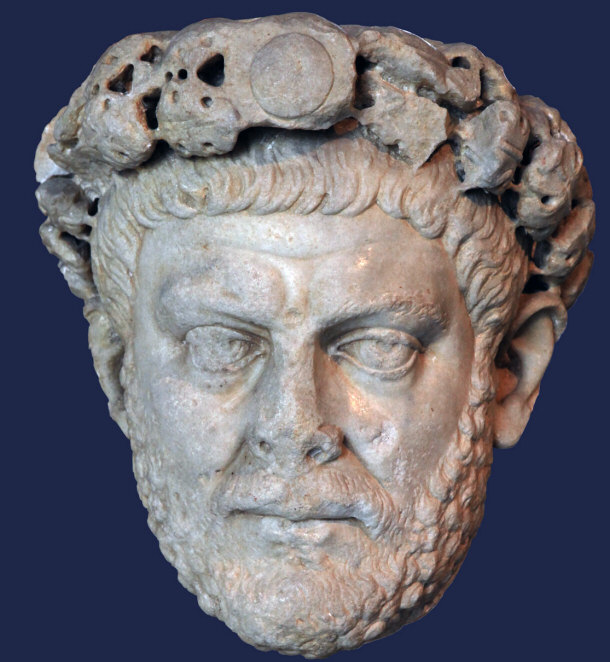
What made him infamous was the Diocletianic Persecution. The Emperor was a
conservative adherent of the traditional Roman faith and its pantheon. The
failed auspices in 299 caused a string of events that eventually culminated in
an Empire-wide persecution of Christians, with Galerius, an Augustus of the
Empire, pushing Diocletian for total extermination of Christians throughout the
Empire to please the gods. Massacres, torture, mutilation, and other
unpleasantries became common during the Great Persecution, eventually making
Diocletian one of the most reviled emperors, at least among Christians.
Ironically, Constantine, the successor of Diocletian after the latter's
departure due to poor health, would result in the establishment of Christianity
as the state religion in the Empire.
6) Romulus Augustus (A.D. 475-476)
Romulus Augustus is hardly an infamous Emperor. After all he reigned for
barely two years. Rather, he is included as the puppet Emperor of a crumbling
Roman Empire. The fifth century was hard on the Roman Empire. A shadow of its
former self, it became a client state of the Eastern Roman Empire ruled out of
Constantinople. Romulus was installed on the throne by his father, and was used as a
smoke screen to disguise his parent's machinations. This wasn't a unique
situation by any means, Romulus just happened to be the last of a string of
figureheads installed on the throne of the Western Roman Empire.
Romulus Augustus Resigning the Crown Before Odoacer
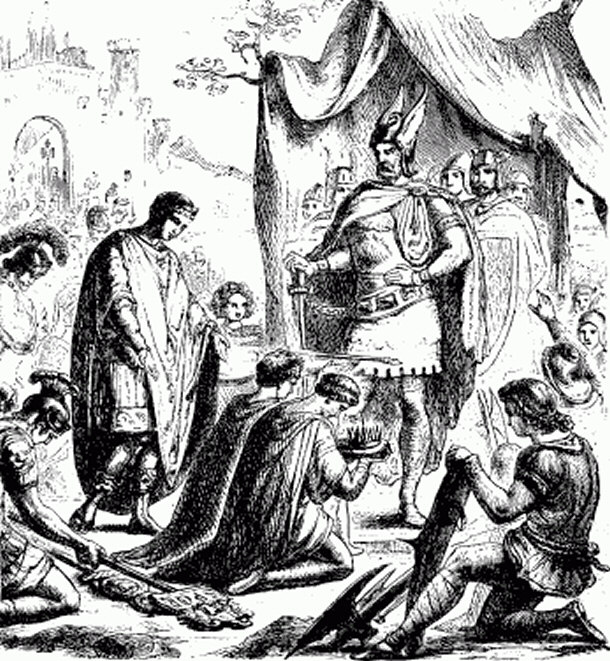
What makes Romulus stand out is the fact that he presided over the death of
the West. Deposed in 476 by Germanic warchief Odoacer, who sacked Rome (again)
and sent the boy Emperor to live in Campania (present-day France). The last
emperor of the fallen Empire became a footnote in history, as the trail goes
cold when he reaches Castellum Lucullanum in Campania, never to surface in
historical record again.
5) Justin II (A.D. 565 – 574)
A Byzantine Emperor of the Justinian dynasty, Justin II was an ambitious
Emperor that attempted to repair the damaged state in which the Byzantine Empire
found itself. With an empty treasury, he attempted to rectify the situation by
cutting subsidies and discontinuing the practice of buying off political
enemies. As the successor of Justinian I, one of the greatest Emperors of
Byzantium, he found himself constantly in the shadow of his predecessor. His
refusal to pay tribute to the Persians combined with a hostile attitude towards
the Turks, resulted in a bitter war with the Sassanid Empire that resulted in the
loss of Syria and Dara. This would lead to the Emperor losing his mind with
grief.
Justin II
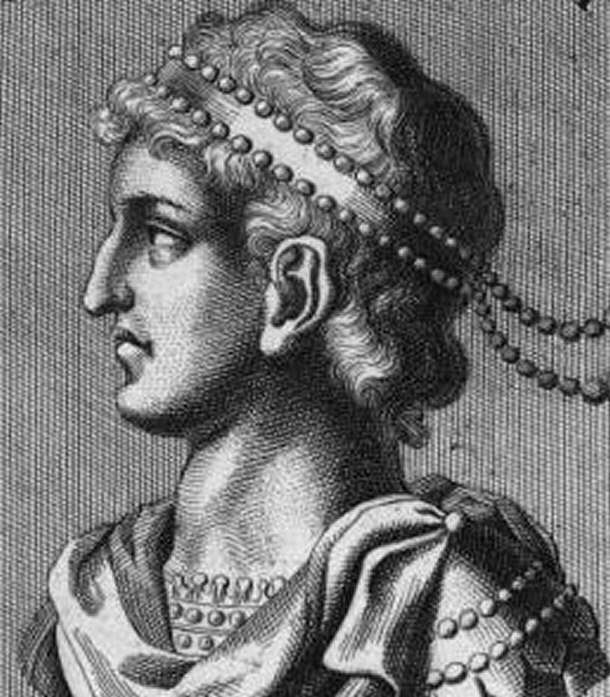
Here's where Justin II's infamy comes in. His fall into insanity resulted, as
suggested by a contemporary historian, in him rolling around the palace on a
wheeled throne and biting passers-by. Allegedly, he also ordered organ music to
be played throughout the palace in a desperate attempt to calm his mind.
Finally, he abdicated the throne to Tiberius, who then ruled on as emperor
regent until Justin II's death in 578.
4) Constantine V (A.D. 741 – 775)
Although the Eastern Roman Empire would continue to exist for nearly a
millennium more, it too had its fair share of terrible rulers. Constantine V was
an accomplished military leader, whose rule was marked by controversy and
instability inside the Empire. Constantine was an instigator of much of its
instability, due to his ruthless policies, especially when it came to dealing
with his political opponents. The civil war with his brother-in-law, Artabasdos,
resulted in Constantine's victory. When Constantine was finally granted access
to Constantinople, the victor immediately ordered a campaign of retaliation
against his political opponents, which resulted in mass
executions.
Leo III the Isaurain Pictured to the Left, Constantine V
Pictured to the Right
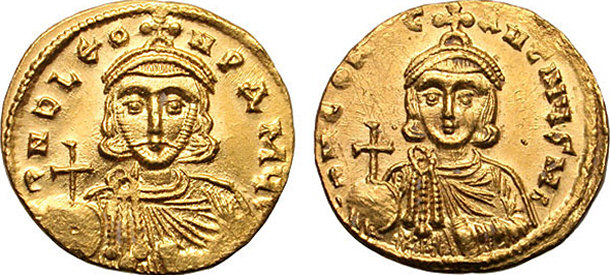
Classical Numismatic Group, Inc. //www.cngcoins.com [GFDL, CC-BY-SA-3.0 or CC-BY-SA-2.5],
via Wikimedia Commons
Another aspect of his reign was iconoclasty. Opposing the veneration of icons
by Orthodox Christians, the Emperor brutally implemented his beliefs, which
included the calling of a synod attended entirely by bishops sympathetic to
inconoclasm. This targeted the monasteries and effectively voided monks' status by forcibly
marrying them off, as well as threatening defiant monks with blinding and exile.
After Constantine's death during the Bulgarian campaign, he was granted the
title of Dung-eater. Finally, as if to underscore the popular contempt for him,
his remains were unearthed in the 9th century and dumped in the sea.
3) Irene of Athens (A.D. 797 – 802)
A talented and intelligent empress consort and empress dowager of the
Byzantine Empire, Irene was originally the wife of Emperor Leo IV. When her
husband died in 780, Irene became regent for their son, Constantine VI. She
immediately countered a conspiracy that sought to depose her son and install
another on the throne of the Empire in an incredibly clever way. By ordaining
the pretenders to the throne as priests, she effectively eliminated them from
the succession line. Apart from a humiliating loss in Anatolia, her rule was an
accomplished one. The question is, why is she infamous?
Constantine VI to the Left and Irene of Athens to the Right

By PHGCOM [CC-BY-SA-3.0 or GFDL],
via Wikimedia Commons
The primary reason for the infamy surrounding her is her relation with her
son. A female on the throne of the Empire was unthinkable to many of its
citizens. When the army declared Constantine as the ruler of the Byzantine
Empire, the Basilissa (claims that she referred to herself as a male Basileus,
i.e. Emperor, are unfounded, except for three instances in her whole reign)
moved to defuse the situation in perhaps the worst possible manner. Organizing a
conspiracy of her own, she had her own son seized and blinded to deny him the
throne. This did not endear her court to her and she was finally deposed in 802
and exiled to Lesbos, where she died in crippling poverty.
2) Basil II the Bulgar-Slayer (A.D. 960 – 1025)
One of the greatest military leaders in the history of the Eastern Roman
Empire was responsible for expanding the Empire to its greatest territorial
extent, and restoring its territories lost to the Muslim conquests five centuries
earlier. Perhaps one of his most interesting campaigns was the conquest of
Bulgaria, which occurred in two stages. The first was a failed invasion in 986,
when his advancing forces were ambushed and nearly wiped out at the Gates of Trajan.
Painting of Basil II Replicated From an 11th Century
Manuscript
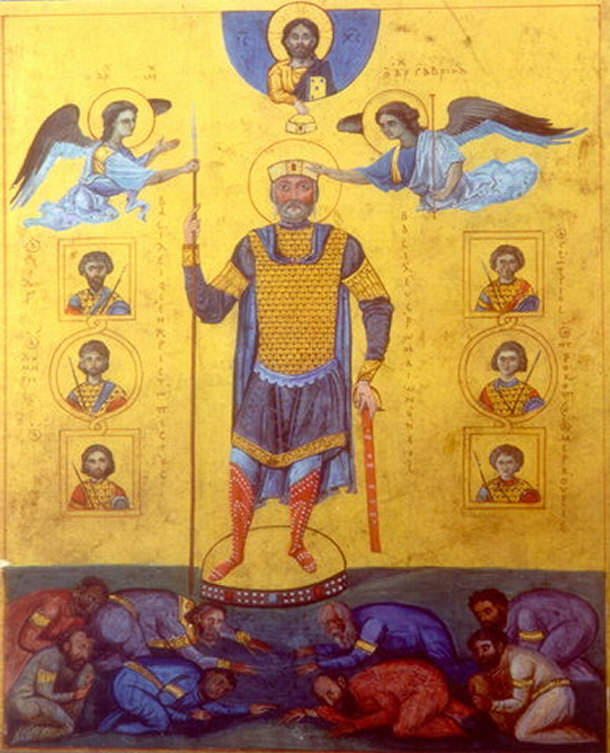
The second attempt was a gradual advance into Bulgaria, annexing it bit by
bit between 1000 and 1018. Here, the infamy comes into play. Basil II was
nicknamed the Bulgar-Slayer due to his military victory and one of the most
terrible actions he committed: after the Battle of Kleidon, the emperor ordered
15,000 Bulgar prisoners to be blinded, sparing every one hundredth soldier as a
guide. At the sight of his army blinded, the King of Bulgaria reportedly
suffered a stroke that killed him a few days later.
1) Alexios III Angelos (A.D. 1195-1203)
Alexios was one of the least competent Byzantine Emperors. Ascending to the
throne through political maneuvering, exploiting Emperor Isaac II Angelos' poor
judgment in handling the problematic succession to the throne of the Empire.
Alexios claimed the throne with help from the Byzantine military and his wife,
Euphrosyne. Starting his reign on a good note, he blinded the former Emperor and
kept him close as a prisoner. His skill in handling former Emperors extended to
his management of the Empire.
Alexios III Angelos
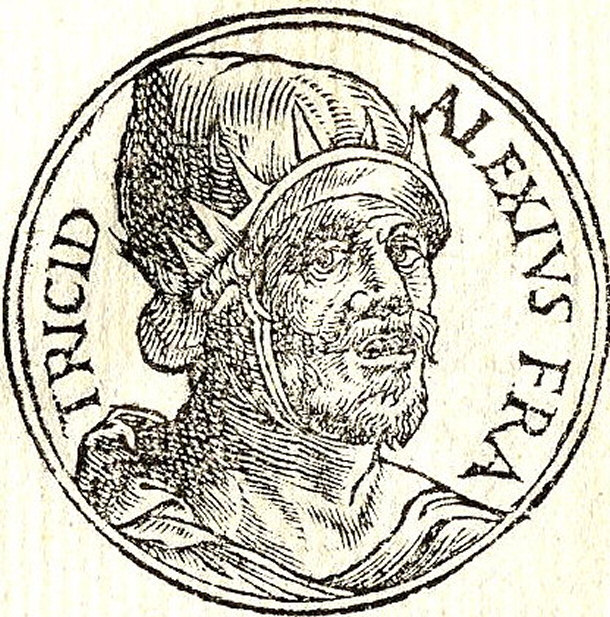
The Byzantine Empire was ruined by Alexios' reign. To solidify his reign,
Alexios spent excessive amounts of money from the state treasury on bribes,
effectively ruining the finances of the Empire. To make things worse, he was
forced to pay an extortionate amount of gold to the Holy Roman Emperor Henry VI
to avoid an invasion. To gain the 1,600 pounds of gold Alexios ordered the
imperial tombs at the Church of the Holy Tombs to be plundered. His
mismanagement brought ruin to the Empire, culminating in the sacking of
Constantinople during the fourth crusade, his dethronement, and the return of
Isaac II Angelos to the throne.
Conclusion
Spanning two millennia, the history of Rome and the Roman Empire that was born
out of it is enough to fill scores of books, especially when one focuses on the
lives of the Emperors. Infamy and fame are both relative and while there were
several rulers that could only be classified as terrible, there were plenty more
that fell in the gray area between true greatness and total pettiness. It all
depends on who passes judgment. Some will appreciate Diocletian's efforts to
stabilize the Empire and breathe life into it, while others will unanimously
declare him as devil's incarnate due to his persecution. However, to truly be
able to formulate an opinion, remember to research. There are plenty of weird,
intriguing, famous, revolting, and downright inspiring facts in the lives of the
emperors and empresses.
History
Top Lists:
15 Biggest Architectural Blunders
Top 15 Most Horrifying Terrorist Attacks
15 Fascinating Facts About the Vietnam War
Top 15 Amazing Ancient Egyptian Architecture
20 Little Known Facts About the Titanic
Top 10 Most Creepiest Abandoned Places in the World
26 Interesting Facts About Henry Ford
List of 15 Tough Ancient Warriors Through History
List of 15 Notorious Roman Emperors and Empresses
Top 15 Worst Pandemics in History
15 Things That Remained the Same in the Past 100 Years
Top 15 Things China Invented First
Top 15 Greatest Inventors in History
15 Interesting Facts About Abraham Lincoln
10 Inventors Who Stole Their Ideas
15 Stories of Hilarious Medieval Victories
15 Detectives Credited With Solving The Biggest Cases In History
15 Fascinating Facts About the Ancient Pyramids
15 Inventions That Were the Result of a Mistake
15 Famous Stories of Execution
16 Rare Facts About the U.S. Presidency
15 Astonishing Leadership Stories that Ended up Successfully
Informational:
Analysis of the Linear B tablets and Wall Paintings
Aristophanes and Classical Greek Comedy
The First War of Scottish Independence
|